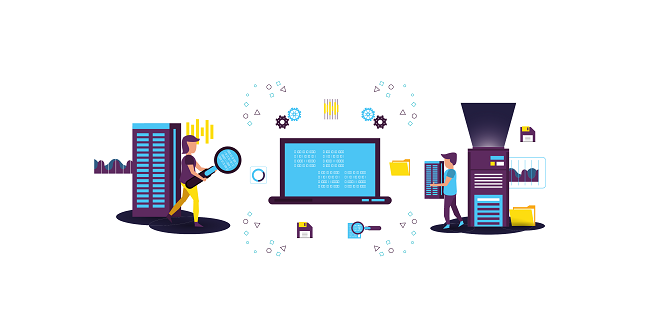Companies collect large volumes of data from multiple sources daily. Some of it can be structured or unstructured, while another portion can be semi-structured. The data is useful to companies but handling it can prove problematic.
Organizations may use it to predict market behavior, machine learning projects, and the enhancement of products. For the data to be used by an organization, it must be collected, stored, and retrieved fast for analysis. Different strategies will help companies achieve this goal.
Using RAM
When companies are processing huge data sets, the main problem that arises is speed. Organizations need to process the data fast to benefit from the analysis reports. If the process is delayed due to I/O bottleneck issues, a company could lose a critical business opportunity. I/O bottleneck issues arise when an organization attempts to store or access mass data from disks.
The benefits of in-memory computing are important when handling challenges of speed. RAM can affect data processing speed significantly. It removes speed limitations in several ways. It moves data from disks or warehouses and stores it in operational memory within the computer system.
Data stored in RAM can be accessed many times faster than retrieving it from other types of storage. Due to this, companies get the opportunity to process data at a greater speed. An application is needed to help make data available even when the computer loses power. A single RAM cannot be enough to handle big data. To solve the challenge, organizations connect multiple RAMs in parallel. Each RAM stores a certain chunk of the data and makes it available whenever needed.
Use of mainframes
Every organization that wants to build a strong business may consider the mainframe as a solution for handling big data. The mainframe is used for a wide range of transactions, such as purchase approvals or checking passengers at airports. The banking sector and major retail stores have used mainframes for many decades. They are used for processing huge volumes of data super-fast.
Companies’ processes such as financial transactions, processing orders, and storage of customer data are done through the mainframe. It is useful when managing inventory, production, and payrolls. These are processes that produce terabytes of data and need enhanced storage solutions.
Mainframes are built to accurately handle millions of processes with no downtime. They provide organizations with a wide range of benefits. They can be upgraded anytime and will not affect business processes. Mainframes use high-end technology for clustering I/O that allows it to maintain high performance all the time. This makes the mainframe architecture available, reliable, and scalable.
The modern mainframe has been upgraded so much that it occupies lesser space. Even if it is smaller, it can handle billions of transactions super-fast, in real-time, and with utmost accuracy. If the system records errors, it self-checks and self-recovers in milliseconds.
During storage, the mainframe divides data into multiple chunks. Each chunk is stored independently in separate operating systems. This makes mainframes perfect choices for storing data securely and providing backup. It can be expanded and connected to other large mainframes to help handle data more efficiently.
Data automation – Apache Spark
Organizations generate a large amount of data every second. The marketing team generates large volumes of orders daily. Companies record millions of payments, order deliveries, and other types of transactions. Some orders are placed through phone calls, others through social media, emails, and the company’s ordering system. Recording all this information manually can be tedious. This is where the need for automation comes in.
During automation, data quality must be prioritized. Prioritization must start from the data source to storage and retrieval. One of the data automation solutions used by companies is Apache Spark. It is a multipurpose distributed computer system that provides solutions for analyzing and processing big data. Apache Spark distributes data in different clusters and then processes it in parallel.
The main technology behind Apache Spark is the master/slave driver, which communicates with large numbers of executors. The software used by Spark is made of multiple drivers and executors. The executors can be termed as workers and drivers as the central coordinator. This makes it possible to launch Spark on several computers. It can work with other open-source applications to enhance its capabilities.
Distributed data caching
Computers store recently accessed data in the cache to make it readily available. It is temporary storage that holds only the most recently accessed data. When handling big data, organizations look for different ways to solve the challenges of generating, storing, and retrieving data. One of the innovations used is distributed data caching.
This technique uses cache as an intermediary layer that connects the database and the user. Primarily, the cache retrieves data from the storage location and stores it closer to the end-user. Large data stored in warehouses or other storage solutions need to be accessed often. Companies use it to analyze the market or study customer behavior. They analyze customer complaints or comments to get an idea of how to improve services.
Every data accessed could bring a unique business opportunity to the organization. If it takes too long to access and process the data, the company’s competitors can have an advantage. Due to this, the speed of access and processing of data must be multiplied by a thousand times more.
One of the solutions is to store the data closer to the end-user. When the data is brought closer, it becomes easier to access it thousands of times faster. This is the role that cache plays when handling big data.
Cache data distribution is more useful in data accessed often. These can be applications used by customers to interact with the company. They make millions of requests per second and make millions of payments for orders. If the ordering and payment processes are too slow, customers may abandon the process and source from the competitors.
Single cache memory cannot handle larger data sets. It would lead to downtimes often, which can affect customer service. This is where distributed catching solutions come in. Instead of relying on a single node, the cache is distributed across different nodes/networks. This provides a truly scalable big data solution to organizations.
 Isaiminia World Breaking News & Top Stories
Isaiminia World Breaking News & Top Stories




